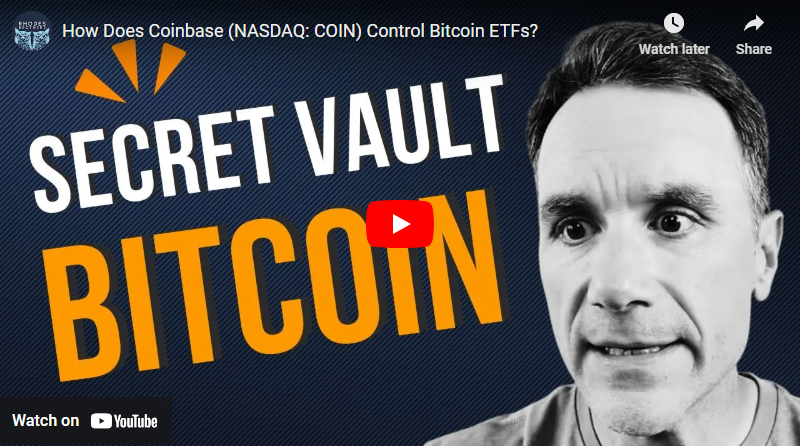For More Free Videos, Subscribe to the Rhodes Brothers YouTube Channel.
Unlocking the potential of Bitcoin ETFs doesn’t have to be a mystery. With the right strategies, anyone can navigate this exciting investment landscape and potentially reap significant rewards. This comprehensive guide will equip you with the knowledge and tools to confidently approach Bitcoin ETFs, understanding the crucial role Coinbase plays and how to mitigate potential risks.

Let’s start with a story. You’re a small-time investor, intrigued by Bitcoin but hesitant about the complexities of self-custody. Bitcoin ETFs seem like a perfect solution – a simple way to gain exposure to the cryptocurrency market. But what’s happening behind the scenes? That’s where understanding Coinbase’s role becomes critical.
John S. Rhodes of Rhodes Brothers aptly stated, “If the government wanted to choke out Bitcoin…what better way to choke out Bitcoin than to go after the company that is storing the Bitcoin in its vault…just go after coinbase.” This highlights a key risk we’ll delve into.
TL;DR
- Coinbase’s Central Role: Coinbase is the custodian for a large percentage of Bitcoin held by ETFs, creating a single point of failure.
- Off-Chain Transactions: Bitcoin moves within Coinbase without appearing on the public blockchain, raising transparency concerns.
- Concentration Risk: The heavy reliance on Coinbase introduces significant risk.
- Regulatory Scrutiny: Coinbase’s central position makes it a potential target for regulatory action.
- Mitigating Risks: Diversification, understanding off-chain mechanics, and staying informed are crucial.
Understanding the Inner Workings of Bitcoin ETFs and Coinbase
Bitcoin ETFs (Exchange-Traded Funds) offer a convenient gateway to Bitcoin investment without the complexities of self-custody. However, understanding the mechanics, particularly Coinbase’s significant role, is crucial for informed decision-making. This section will delve deeper into the intricacies of how these ETFs function and the potential implications.
Coinbase: The Central Hub and its Associated Risks

The YouTube transcript highlights a striking reality: approximately 90% of Bitcoin held within Bitcoin ETFs is stored by Coinbase. This makes Coinbase not just a significant player, but arguably the central player, acting as a custodian and facilitating a large volume of off-chain transactions. While this centralized structure offers operational efficiency for large institutional investors, it introduces substantial risks. Let’s examine these risks in detail:
- Single Point of Failure: The heavy reliance on Coinbase creates a single point of failure. If Coinbase experiences a security breach, regulatory action, or any significant operational disruption, the ripple effect could be devastating for the entire Bitcoin ETF market. This concentration of risk is a critical factor to consider.
- Counterparty Risk: Investing in a Bitcoin ETF inherently involves trusting Coinbase to securely hold and manage the underlying Bitcoin assets. While Coinbase is a large and established company, counterparty risk – the risk that the other party in a transaction may default – always exists.
- Regulatory Uncertainty: The regulatory landscape surrounding cryptocurrencies is constantly evolving. Coinbase, as a central player, is particularly vulnerable to regulatory scrutiny. Changes in regulations could significantly impact Coinbase’s operations and, consequently, the Bitcoin ETF market.
- Operational Risks: Any operational failures within Coinbase, such as system outages or processing errors, could disrupt the trading of Bitcoin ETFs and impact investor access to their assets.
Off-Chain Transactions: Unveiling the Transparency Issue
Unlike traditional stock transactions, which are publicly recorded and easily auditable, a significant portion of Bitcoin ETF transactions occur off-chain within Coinbase’s internal system. This means the movement of Bitcoin isn’t visible on the public, transparent blockchain. While this may offer privacy benefits for large institutional investors who wish to conduct large transactions without revealing their market activity, it raises concerns about transparency for the average investor. This lack of visibility makes it difficult to independently verify the accuracy of reported holdings and transactions.
- Reduced Transparency: The off-chain nature of many transactions reduces the transparency and auditability of the entire process. Investors rely on Coinbase’s reporting, which, while generally reliable, lacks the inherent transparency of on-chain transactions.
- Potential for Manipulation: While unlikely given Coinbase’s size and reputation, the lack of public visibility of off-chain transactions theoretically creates a potential, albeit small, for manipulation. This is a risk that needs to be acknowledged, however remote.
- Limited Independent Verification: It is significantly more difficult for independent parties to verify the accuracy of the reported holdings and transactions of Bitcoin ETFs due to the reliance on off-chain mechanisms.
Deep Dive into Mitigating Risks: A Multi-Faceted Approach
Investing in Bitcoin ETFs requires a sophisticated understanding of the risks involved. A multi-pronged strategy is essential for mitigating these risks effectively. Let’s break down a comprehensive approach:
Step 1: Thorough Due Diligence
Before investing in any Bitcoin ETF, conduct thorough due diligence. This goes beyond simply reading the prospectus. Research the ETF’s investment strategy, fee structure, and the track record of the fund manager. Understand the fund’s underlying holdings and how they are managed. Pay close attention to the fund’s custodial arrangements and the level of transparency provided. Utilize tools like Bloomberg Terminal (subscription required) for in-depth market data and analysis, or TradingView for charting and technical analysis of Bitcoin and other assets.
Step 2: Diversification: The Cornerstone of Risk Management
Diversification is paramount. Don’t concentrate your investments solely in Bitcoin ETFs. Spread your investments across various asset classes, including other cryptocurrencies, stocks, bonds, and real estate. This reduces your overall portfolio risk, mitigating the impact of any single investment’s underperformance or unexpected events affecting a specific asset. Tools like portfolio management software (e.g., Personal Capital, Betterment) can assist in tracking and optimizing your diversified portfolio.
Step 3: Staying Informed: The Importance of Continuous Monitoring
The cryptocurrency market is dynamic. Stay informed about news and developments affecting the Bitcoin ETF market, Coinbase’s operations, and the regulatory landscape. This includes monitoring regulatory changes, security breaches, and any significant market events that could impact your investments. Reliable news sources, industry publications, and reputable analysts can help you stay informed. Consider using Google Alerts to receive notifications about relevant news and updates.
Step 4: Risk Tolerance Assessment: Knowing Your Limits
Before investing, honestly assess your risk tolerance. Bitcoin is notoriously volatile. Are you comfortable with the potential for significant price swings and potential losses? If not, you might consider reducing your allocation to Bitcoin ETFs or choosing less volatile investment options. Online risk tolerance questionnaires can help you determine your appropriate risk level.
Step 5: Investment Goals: A Clear Roadmap
Clearly define your investment goals. Are you investing for short-term gains or long-term growth? Your investment strategy should align with your goals. If your time horizon is short, the volatility of Bitcoin ETFs might not be suitable.
Advanced Strategies and Tools for Sophisticated Investors
For more sophisticated investors, a deeper understanding of technical analysis, market sentiment, and macroeconomic factors can inform investment decisions. Tools such as:
- Sentiment Analysis Tools: These tools analyze social media and news articles to gauge market sentiment towards Bitcoin. Examples include tools offered by various social media analytics platforms.
- On-Chain Data Analysis: Analyzing on-chain metrics, such as transaction volume and network activity, can provide insights into Bitcoin’s price trends. Platforms like Glassnode and IntoTheBlock offer this type of data.
- Macroeconomic Indicators: Understanding macroeconomic factors, such as inflation and interest rates, can help predict Bitcoin’s price movements. Resources like the Federal Reserve Economic Data (FRED) website provide this information.
- Portfolio Management Software: Tools like Personal Capital or Betterment can help track your portfolio’s performance, manage risk, and optimize your asset allocation.
- Cryptocurrency Data Aggregators: Websites like CoinMarketCap and CoinGecko provide real-time pricing and market data for Bitcoin and other cryptocurrencies, allowing for informed decision-making.
By combining these advanced strategies and utilizing the mentioned tools with the fundamental risk mitigation techniques outlined above, investors can navigate the complex world of Bitcoin ETFs with greater confidence and potentially maximize their returns while minimizing their risks. Continuous learning and adaptation are crucial in this dynamic market.
Actionable Steps for Navigating Bitcoin ETFs
Investing in Bitcoin ETFs requires a strategic approach tailored to individual circumstances. Here’s a breakdown of actionable steps categorized by investor profile:
Beginners
- Education First: Before investing a single dollar, dedicate time to understanding the basics of Bitcoin, ETFs, and investing in general. Utilize free online resources like Investopedia, Khan Academy, and YouTube channels dedicated to financial literacy.
- Start Small: Begin with a small investment amount you’re comfortable losing. This allows you to gain experience without significant financial risk. Consider starting with a fraction of your overall investment portfolio.
- Choose a Reputable Broker: Select a brokerage platform known for its security, user-friendliness, and regulatory compliance. Read reviews and compare fees before making a decision.
- Focus on Diversification: Even with a small investment, prioritize diversification. Don’t put all your eggs in one basket. Allocate a small percentage of your portfolio to Bitcoin ETFs, and the rest to other, less volatile assets.
- Avoid Emotional Decisions: Market volatility is normal. Avoid making impulsive decisions based on fear or greed. Stick to your investment plan.
- Regularly Monitor Your Investments: Track your investment performance, but avoid obsessive checking. Regularly review your portfolio (e.g., monthly or quarterly) to ensure it aligns with your goals and risk tolerance.
Millennials
- Long-Term Perspective: Millennials generally have a longer time horizon for investments. This allows them to tolerate more risk. Consider allocating a larger portion of your portfolio to Bitcoin ETFs compared to beginners, but still maintain diversification.
- Dollar-Cost Averaging (DCA): Instead of investing a lump sum, consider DCA. This involves investing a fixed amount at regular intervals (e.g., monthly). This strategy mitigates the risk of investing at a market peak.
- Explore Different ETF Options: Research various Bitcoin ETFs available, comparing their expense ratios, investment strategies, and underlying holdings.
- Utilize Automated Investing Tools: Many brokerage platforms offer automated investing tools that allow you to set up recurring investments and rebalance your portfolio automatically.
- Stay Informed About Technological Advancements: Millennials are often more tech-savvy. Stay updated on technological developments in the cryptocurrency space that could impact Bitcoin’s price and the ETF market.
- Consider ESG Factors: If ESG (environmental, social, and governance) factors are important to you, research Bitcoin ETFs with strong ESG profiles.
Individuals Nearing Retirement
- Prioritize Capital Preservation: Individuals nearing retirement should prioritize capital preservation over high-risk investments. Allocate a very small percentage of your portfolio to Bitcoin ETFs, if any.
- Focus on Low-Risk Investments: The majority of your portfolio should be invested in low-risk, stable investments like bonds and government securities.
- Consult a Financial Advisor: Seek advice from a qualified financial advisor before making any investment decisions. They can help you create a retirement plan that aligns with your risk tolerance and financial goals.
- Understand the Tax Implications: Be aware of the tax implications of investing in Bitcoin ETFs. Consult a tax professional to understand how these investments will affect your tax liability.
- Avoid Speculative Investments: Avoid speculative investments that could jeopardize your retirement savings. Bitcoin ETFs are inherently speculative, so limit your exposure.
- Regularly Review Your Retirement Plan: Review your retirement plan regularly with your financial advisor to ensure it remains on track to meet your retirement goals.
Common Mistakes to Avoid in Bitcoin ETF Investing
Investing in Bitcoin ETFs, while potentially lucrative, presents several pitfalls that can significantly impact your returns if not carefully navigated. Let’s delve into common mistakes and their solutions:
-
Ignoring Risk: Beyond Volatility
Don’t simply underestimate the volatility of Bitcoin; truly understand the inherent risks. Bitcoin’s price is notoriously susceptible to dramatic swings, influenced by factors ranging from regulatory announcements and macroeconomic conditions to social media trends and technological advancements. These fluctuations can cause significant short-term losses, even if the long-term outlook remains positive.
Solutions: Before investing, conduct a thorough risk assessment using online tools to determine your comfort level with potential losses. Only invest an amount you can afford to lose without jeopardizing your financial stability. Diversify your portfolio across multiple asset classes to mitigate the impact of Bitcoin’s volatility. Regularly review and adjust your portfolio allocation based on market conditions and your evolving risk tolerance.
-
Over-Investing: The Dangers of Concentration Risk
While Bitcoin’s potential for growth is enticing, avoid the trap of over-investing in Bitcoin ETFs. Concentrating a significant portion of your portfolio in a single asset class, especially one as volatile as Bitcoin, exposes you to substantial risk. If the Bitcoin market experiences a downturn, your entire portfolio could suffer disproportionately.
Solutions: Implement a diversified investment strategy across various asset classes, including stocks, bonds, real estate, and other alternative investments. A well-diversified portfolio reduces your exposure to any single asset’s volatility. Develop a clear asset allocation strategy aligned with your risk tolerance and financial goals. Utilize portfolio tracking tools to monitor your asset allocation and rebalance as needed to maintain your target diversification.
-
Ignoring Fees: The Silent Eaters of Returns
Expense ratios and trading fees associated with Bitcoin ETFs might seem insignificant at first glance, but they cumulatively erode your returns over time. High fees can significantly reduce your overall profits, especially over the long term. Carefully compare the fee structures of different Bitcoin ETFs before making a decision.
Solutions: Actively compare the expense ratios of various Bitcoin ETFs before investing. Prioritize ETFs with low expense ratios, as even minor differences can significantly impact long-term returns. Factor in trading fees charged by your brokerage platform when calculating the overall cost of ownership. Use online comparison tools to easily compare fees across multiple ETFs to make an informed decision.
-
FOMO (Fear Of Missing Out): The Emotional Trap
The hype surrounding Bitcoin can trigger FOMO, leading to impulsive investment decisions based on emotion rather than rational analysis. Investing based on hype or fear of missing out is a recipe for poor investment outcomes. Remember, informed decisions are based on thorough research and a clear understanding of your risk tolerance.
Solutions: Develop a disciplined investment strategy based on thorough research and a realistic assessment of your risk tolerance. Avoid impulsive decisions driven by market sentiment or social media trends. Adhere to your pre-defined investment plan, even during periods of high volatility. Remember that market timing is notoriously difficult, and a long-term, well-diversified approach is generally more successful. Consider employing a dollar-cost averaging (DCA) strategy to mitigate the risk of investing at market peaks.
By understanding and addressing these common mistakes and implementing the provided solutions, you can significantly improve your chances of successful Bitcoin ETF investing. Remember, responsible investing involves thorough research, careful planning, and a clear understanding of your own risk tolerance.
Frequently Asked Questions
Are Bitcoin ETFs safe?
Bitcoin ETFs, like any investment, carry inherent risks. The concentration of Bitcoin in Coinbase introduces a significant risk factor. Diversification and careful risk assessment are crucial.
How do I buy Bitcoin ETFs?
You can buy Bitcoin ETFs through a brokerage account, similar to buying stocks. Research different brokers and choose one that suits your needs.
What are the fees associated with Bitcoin ETFs?
Bitcoin ETFs have expense ratios, similar to mutual funds, which represent the annual cost of managing the fund. There may also be brokerage commissions for buying and selling the ETFs.
How volatile are Bitcoin ETFs?
Bitcoin ETFs are highly volatile, reflecting the inherent volatility of Bitcoin itself. Be prepared for significant price swings.
What is the difference between on-chain and off-chain transactions?
On-chain transactions are recorded on the public Bitcoin blockchain, while off-chain transactions occur within a private system, like Coinbase, and are not publicly visible.
What is the regulatory landscape for Bitcoin ETFs?
The regulatory landscape for Bitcoin ETFs is constantly evolving. Stay informed about any changes in regulations that could impact your investments.
Is Coinbase a secure platform?
Coinbase is a large and established cryptocurrency exchange, but like any platform, it’s not immune to security risks. Stay informed about their security measures.
How can I mitigate the risk of Coinbase’s central role?
Diversify your investments, don’t over-invest in Bitcoin ETFs, and stay informed about Coinbase’s operations and the regulatory landscape.
What happens if Coinbase is compromised?
A compromise of Coinbase could significantly impact the Bitcoin ETF market, leading to potential losses for investors.
Are there alternatives to Coinbase-custodied Bitcoin ETFs?
While many ETFs currently rely heavily on Coinbase, the market is evolving. Research and compare different ETFs to see if alternatives exist with different custodial arrangements. However, it’s important to note that a high degree of centralization is a common characteristic of the current Bitcoin ETF market.
Charting Your Course
This exploration of Bitcoin ETFs and Coinbase’s central role has revealed both the potential and the pitfalls of this investment landscape. Remember, informed investing is about understanding the mechanics, mitigating risks, and aligning your strategy with your individual circumstances.
Key Takeaways:
- Coinbase’s Central Role: Coinbase’s significant role as custodian for a large percentage of Bitcoin held by ETFs creates a concentration of risk. Understanding this centralization is crucial for informed decision-making.
- Off-Chain Transactions and Transparency: The prevalence of off-chain transactions reduces transparency, highlighting the importance of relying on reputable sources for information and due diligence.
- Risk Mitigation Strategies: Diversification, thorough research, and a realistic assessment of your risk tolerance are essential for navigating the volatility of the Bitcoin market.
- Actionable Steps: Begin with education, start small, and gradually increase your investment as your understanding grows. Always prioritize diversification and avoid emotional decision-making.
Actionable Tips to Implement Immediately:
- Research: Dedicate time to understanding Bitcoin, ETFs, and investing in general using reputable online resources.
- Diversify: Don’t put all your eggs in one basket. Spread your investments across different asset classes.
- Assess Risk: Honestly evaluate your risk tolerance before investing any significant amount.
- Monitor Fees: Compare expense ratios and trading fees across different Bitcoin ETFs.
- Stay Informed: Keep up-to-date on news and developments affecting the Bitcoin ETF market.
Ready to take control of your Bitcoin ETF investments? Start by researching reputable ETFs and comparing their fees and investment strategies. Then, create a diversified portfolio that aligns with your risk tolerance and financial goals.
Thank you for joining us on this journey into the world of Bitcoin ETFs. We encourage you to continue your learning and stay informed. For more in-depth analysis and insights into the ever-evolving cryptocurrency market, subscribe to the Rhodes Brothers YouTube Channel for the latest videos and information to help you succeed.
Resource List
Books
- “The Bitcoin Standard: The Decentralized Alternative to Central Banking” by Saifedean Ammous (Focuses on the underlying technology and economic principles)
- “Cryptoassets: The Innovative Investor’s Guide to Bitcoin and Beyond” by Chris Burniske and Jack Tatar (Provides a broader overview of cryptocurrencies)
Courses & Educational Platforms
Podcasts
- “Unchained” with Laura Shin (Focuses on crypto news and analysis)
- “What Bitcoin Did” with Peter McCormack (Interviews key figures in the Bitcoin space)
Tools & Resources
- CoinMarketCap: Real-time pricing and market data for cryptocurrencies.
- CoinGecko: Similar to CoinMarketCap, offering comprehensive market information.
- TradingView: Charting platform for technical analysis.
- Bloomberg Terminal: (Subscription required) In-depth market data and analysis.
- Glassnode: On-chain data analysis for Bitcoin.
- IntoTheBlock: Provides on-chain and market intelligence.
- Personal Capital or Betterment: Portfolio management software.
- Federal Reserve Economic Data (FRED): Macroeconomic data.






